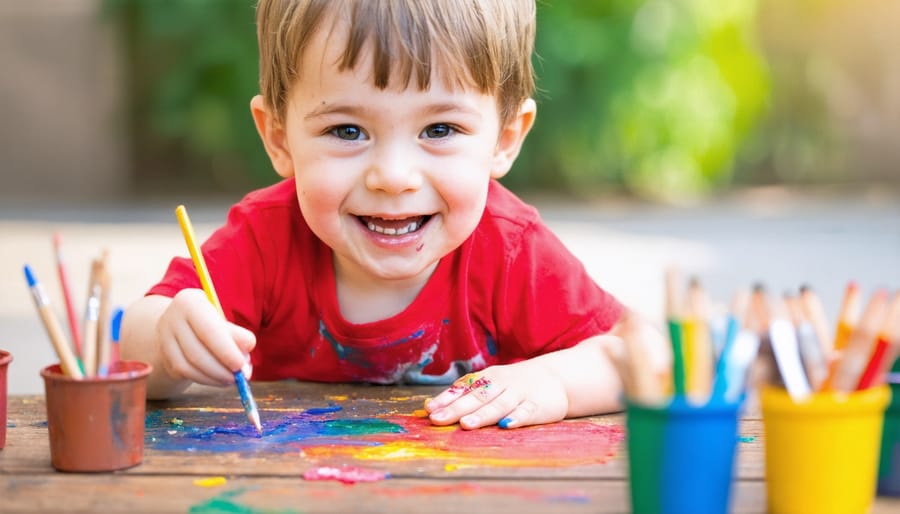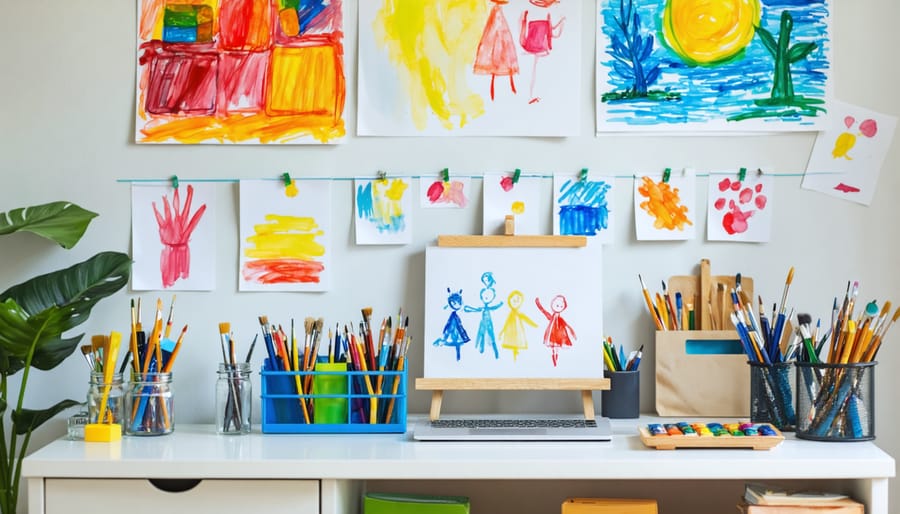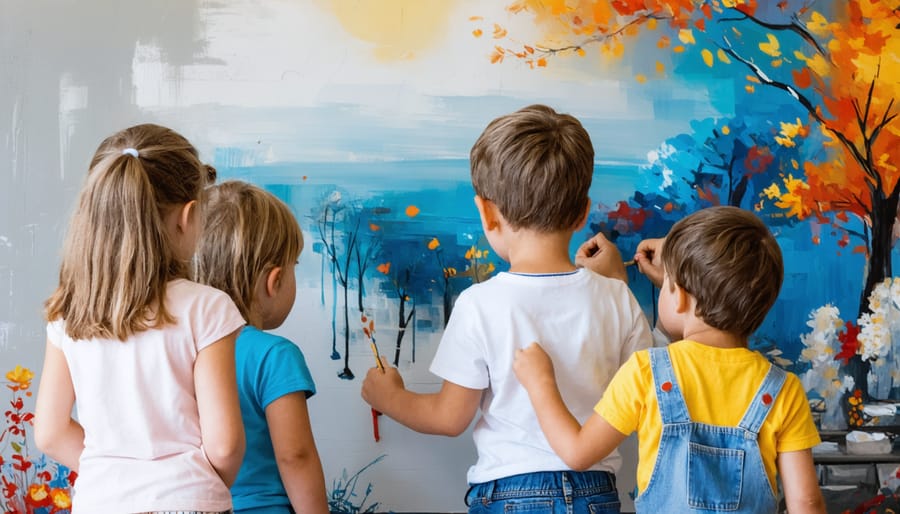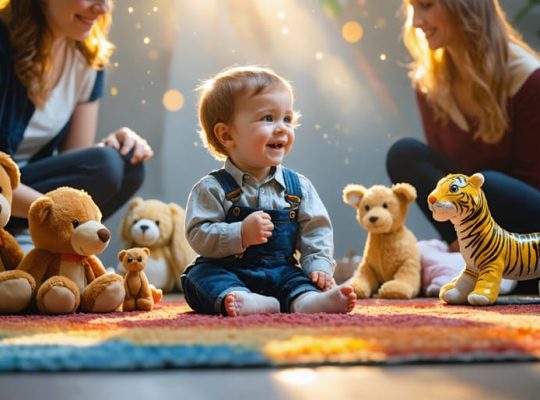Art integration transforms how children learn, creating bridges between creativity and core academic subjects that unlock deeper understanding and engagement. When we weave artistic expression into daily learning, whether through music in math class or drama in history lessons, we tap into children’s natural curiosity and imagination, making complex concepts more accessible and memorable.
Research consistently shows that integrated arts education enhances critical thinking, improves emotional regulation, and boosts academic performance across all subjects. Children who experience art-integrated learning demonstrate stronger problem-solving abilities and show increased confidence in expressing their ideas through multiple mediums.
Beyond the classroom, art integration creates meaningful connections between different areas of knowledge, reflecting how the real world operates through interconnected systems rather than isolated subjects. This holistic approach to learning nurtures well-rounded individuals who can think creatively, communicate effectively, and approach challenges with innovation and flexibility – essential skills for success in today’s rapidly evolving world.
The Power of Art in Child Development
Emotional Expression Through Art
Art serves as a powerful outlet for children to express feelings they might struggle to put into words. When a child picks up a paintbrush or molds clay, they’re not just creating – they’re processing complex emotions through colors, shapes, and textures. A child feeling anxious might use dark, heavy strokes, while happiness often emerges through bright colors and flowing lines.
Through artistic expression, children develop emotional awareness and build healthy coping mechanisms. Drawing or painting can help them work through difficult experiences, like moving to a new school or dealing with family changes. It’s particularly valuable for children who find verbal communication challenging.
Parents and teachers often notice that after an art session, children appear more relaxed and better able to discuss their feelings. The non-judgmental nature of art creation provides a safe space where children can explore their emotional landscape freely, building confidence and self-understanding along the way. This emotional release through creativity becomes an essential tool in their emotional development toolkit.

Building Cognitive Skills
Engaging in artistic activities plays a vital role in cognitive development in children, fostering essential mental skills that benefit them throughout life. When children integrate art into their learning process, they develop stronger problem-solving abilities and enhanced critical thinking skills. Through activities like drawing, painting, and sculpting, children learn to analyze complex shapes, understand spatial relationships, and make creative decisions.
Art integration encourages children to think flexibly and approach challenges from multiple angles. When a child experiments with different colors, textures, and materials, they’re actually strengthening neural pathways that support memory, attention, and visual processing. Dr. Sarah Chen, a child development specialist, notes that “artistic activities engage both hemispheres of the brain simultaneously, promoting whole-brain learning and enhanced cognitive function.”
These creative experiences also help children develop better hand-eye coordination, fine motor skills, and visual discrimination – all crucial components for academic success and everyday tasks.
Creating Art-Rich Learning Spaces
Home Art Stations
Creating a dedicated art space at home doesn’t require a large budget or extensive renovations. Start by choosing a well-lit area with good ventilation and easy-to-clean surfaces. A corner of the kitchen, a spot in the playroom, or even a portable cart can serve as your family’s creative hub.
Stock your art station with age-appropriate materials like washable markers, colored pencils, child-safe scissors, and recycled materials. Consider adding a small table or desk at the right height for your child, and use clear containers to organize supplies, making them visible and accessible.
Make the space inviting by displaying your child’s artwork and rotating pieces regularly. Include storage solutions like hanging files for paper, mason jars for brushes, and labeled bins for different materials. A wipeable mat or old tablecloth can protect surfaces and make cleanup easier.
Remember to keep supplies within safe reach and store potentially messy materials like paint up high. Having a designated creative space shows children that their artistic expression is valued and encourages spontaneous creativity throughout the day.

Classroom Integration Ideas
Art integration can enrich learning across all subject areas, making lessons more engaging and memorable for students. In math, students might create geometric patterns or use shapes to explore concepts like symmetry and proportion. Science lessons come alive when students draw detailed observations of plants, animals, or natural phenomena, helping them develop both artistic skills and scientific attention to detail.
For language arts, encourage students to illustrate their stories or create comic strips to represent plot development. This visual storytelling approach helps strengthen both creative writing and artistic expression. In social studies, students can create period-appropriate artwork or recreate historical artifacts, deepening their understanding of different cultures and time periods.
Music teachers can collaborate with art teachers to explore how visual art and music complement each other. Students might paint while listening to different musical pieces, exploring how sound influences their artistic choices. For physical education, incorporate movement-based art activities like dance or creative expression through body movement.
Remember to display student artwork prominently and celebrate creative achievements. This validation helps build confidence and encourages continued artistic exploration across all subjects.
Art-Based Play Activities
Sensory Art Experiences
Art becomes even more powerful when it engages multiple senses simultaneously. Through carefully designed sensory learning activities, children can explore textures, sounds, smells, and movements while creating. Consider finger painting with scented paints, sculpting with textured materials like sand clay, or creating musical instruments from recycled materials.
One kindergarten teacher shared how her students became more focused and expressed themselves better when working with multi-sensory art materials. “When children can squeeze, smell, and manipulate materials while creating, they become fully immersed in the experience,” she explains.
Try incorporating natural elements like leaves, flowers, or bark into art projects to add interesting textures and scents. Sound can be integrated by playing calming background music or encouraging children to create rhythm with their art tools. Movement can be included through dance painting or large-scale collaborative murals where children stretch and reach.
These multi-sensory experiences help develop fine motor skills, emotional expression, and cognitive connections while making art more engaging and memorable for children of all abilities.
Collaborative Art Projects
Collaborative art projects create powerful opportunities for children to develop social skills while expressing themselves creatively. When students work together on murals, group sculptures, or shared canvases, they naturally learn to communicate, compromise, and respect others’ ideas.
One particularly effective activity is the “Peace Through Art” project, where children work in small groups to create a shared vision of harmony and friendship. Each child contributes their unique perspective while learning to blend their ideas with others.
Art teacher Maria Santos shares, “I’ve seen remarkable transformations when children who struggle socially find their place in group art projects. They learn to take turns, share materials, and celebrate each other’s contributions.”
Other successful collaborative activities include friendship quilts, where each child designs a square that connects to their neighbors’ work, and “story sculptures” where groups build three-dimensional representations of shared stories. These projects help children develop empathy, practice conflict resolution, and experience the joy of creating something meaningful together.
Remember to celebrate both the creative process and the final artwork, emphasizing how working together enriches the experience for everyone involved.

Supporting Different Learning Styles Through Art
Art integration is a powerful tool for accommodating different learning styles and creating an inclusive learning environment. Children process and understand information in unique ways, and art provides multiple pathways for engagement and comprehension.
Visual learners thrive when concepts are presented through drawings, diagrams, and color-coding. For these students, creating mind maps with illustrations or using visual art to represent abstract ideas can significantly enhance their understanding. A fourth-grade teacher shared how her students’ grasp of the water cycle improved dramatically when they created colorful murals depicting each stage.
Kinesthetic learners benefit from hands-on art activities that allow them to physically engage with materials. Clay modeling, dance interpretation, and large-scale collaborative art projects help these students connect with the subject matter through movement and touch. One special education instructor noted how her students better understood geometric shapes after creating them using various art materials.
Auditory learners can connect with art through music, rhythm, and verbal expression. Poetry writing, songwriting, and dramatic performances allow these students to process information through sound and spoken word. Musical compositions can help memorize facts, while group discussions about artwork enhance verbal processing skills.
For students who prefer logical approaches, art can be integrated through pattern recognition, systematic color theory, and structured design projects. These activities appeal to their analytical mindset while developing creative thinking skills.
By incorporating multiple artistic approaches, educators can ensure that every student has the opportunity to learn in ways that resonate with their natural learning preferences, leading to better engagement and retention of information.
Art integration offers a powerful pathway to enhance learning, emotional expression, and overall development in children and adults alike. By weaving artistic activities into daily routines, educational settings, and therapeutic environments, we create opportunities for deeper engagement, improved mental well-being, and more meaningful connections. The beauty of art integration lies in its accessibility – anyone can start incorporating creative elements into their existing frameworks, regardless of artistic skill level or available resources.
As we’ve explored throughout this article, the benefits of art integration extend far beyond aesthetic appreciation. From boosting cognitive development and problem-solving skills to providing emotional outlets and building confidence, artistic expression plays a vital role in holistic growth. By embracing art integration, we open doors to more inclusive, engaging, and effective learning experiences.
Whether you’re a parent, educator, or healthcare professional, consider taking small steps to incorporate more artistic elements into your daily interactions with children. The rewards of this creative journey will manifest in countless ways, enriching both the lives of young learners and those who guide them.


